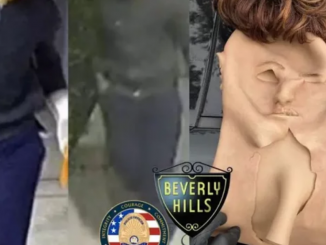
The Bureau of Land Management failed to take the necessary precautions to protect dinosaur tracks at one of the nation’s most important sites near Moab, resulting in irreparable damage — albeit minor — to several of the footprints, according to a report released this week.
The report by the BLM regional paleontologist in Wyoming said that, given the importance of the Mill Canyon Dinosaur Tracksite, the agency should have had an expert review a plan to rebuild a boardwalk and the public should be given a greater opportunity to weigh in before proceeding with the project.
Days after the project began, visitors to the site noticed tire tracks and a backhoe parked near some of the footprints and notified BLM, which halted construction.
“Even though the overall damage to the site was minimal, had the project not been stopped, it is likely that much greater damage would have occurred with increased construction activities,” according to the review by Brent Breithaupt, the regional paleontologist in the BLM’s Wyoming state office.
The report, dated March 8, was released Wednesday.
The Mill Canyon site is considered one of the 10 most important dinosaur tracksites in the nation and one of the most significant sites of early Cretaceous tracks in the world. It is home to some 200 imprints of at least 10 different species of dinosaurs that traversed the area about 112 million years ago.
Breithaupt inspected the site shortly after work was stopped and found several tracks that had been damaged. An important crocodile slide — where a prehistoric crocodile dragged its body through mud — appeared to have been repeatedly driven over by a backhoe and other vehicles causing fracturing.
Another area that contained tracks from several types of dinosaurs had footprints that showed signs of recent breakage and fractures around the rims of the footprints. A large print from a theropod, a two-footed dinosaur, also suffered fragmentation.
Little can be done to restore the damage that was done, Breithaupt wrote in his report. He added that several locations at the tracksite should have been flagged so they could have been avoided.
The walkways and signage are needed to protect the popular tracksite, he wrote, but he said the project should be re-evaluated and that this time that assessment should include a paleontologist and should be made available to the public. And before any work begins, he wrote, the area should be clearly marked and crews briefed on where they can and cannot go.
MCDT Paleontological Assessment March8 2022web508 Copy by Robert Gehrke on Scribd
He also recommended that BLM fill a vacant position for a paleontologist at the Color Country Field Office in Utah.
That spot has been empty since ReBecca Hunt Foster left to be the paleontologist at Dinosaur National Monument in 2018.
In a statement, the bureau said it is committed to protecting fossils on public lands.
“To ensure this does not happen again, we will follow the recommendations in the assessment, seek public input, and work with the paleontology community as we collectively move forward on constructing boardwalks at the interpretive site,” the agency said.
The revised environmental assessment — which will include a paleontologist, study alternative routes and will be available for public comment — should be complete this summer, the agency said.
“It’s good that we stopped more damage from happening,” said Jeremy Roberts, who helped put pressure on the BLM to pause the project, “but this will continue to plague the state until we get a paleontologist down there [in the field office].”
*story by sltrib.com


